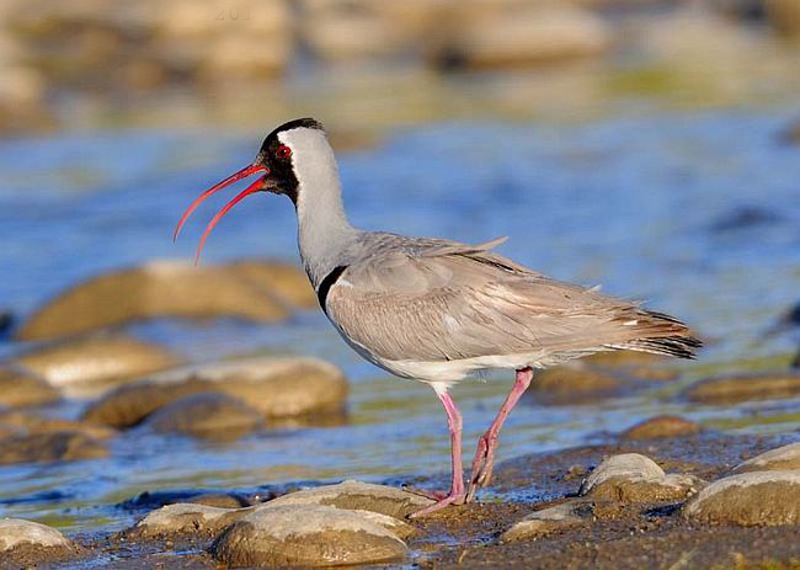Ibidorhyncha struthersii
IUCN
LCBasic Information
Scientific classification
- name:Ibidorhyncha struthersii
- Scientific Name:Ibidorhyncha struthersii,Ibisbill
- Outline:Wading birds
- Family:Ploverformes L.Snipeidae L.S.genus
Vital signs
- length:40cm
- Weight:253-337g
- lifetime:No verification information
Feature
The beak is long and curved downwards, bright red in the breeding season and dark red in other seasons. The feet are bright red in the breeding season and mostly grayish pink in other seasons.
Distribution and Habitat
Origin: Afghanistan, Bhutan, China, India, Kazakhstan, Kyrgyzstan, Myanmar, Nepal, Pakistan, Tajikistan, Turkmenistan, Uzbekistan.
Migrant bird: Russian Federation (Central Asia).
Western Xinjiang, western, southern and eastern Tibet, Qinghai, Gansu, Sichuan, Ningxia, Shaanxi, Hebei, Henan, northern Yunnan, China. Migrant birds are found in Xishuangbanna (southern Yunnan).
Inhabits streams and gravelly river banks in mountainous, plateau and hilly areas. The distribution altitude ranges from near sea level in the east to high mountains of about 4,500 meters in the west. In winter, it is active in low-altitude foothills.
Appearance
The summer plumage of the ibis is black on the forehead, top of the head, face, chin and throat, which are all black, in the form of a continuous black spot surrounded by a narrow white edge. The back of the neck, the sides of the neck, the front neck and the upper chest are blue-gray. The chest has a wide black horizontal band; there is another narrow white breast band between the black breast band and the gray of the upper chest, and the rest of the lower body below the black breast band is generally white. The entire upper body, including the back and shoulders, is gray-brown. The flight feathers on the wings are black-brown with white spots on the inside; the base of the inner primary flight feathers and the outer secondary flight feathers is white, forming a large white spot on the wings. The inner flight feathers are gray-brown. The great coverts and primary coverts are dark brown. The middle coverts and small coverts are gray-brown. The wing edges are white. The upper tail cover
Details
Ibisbill is a gray, black and white sandpiper with no subspecies.

Ibisbill is a resident and vertical migratory bird. They often move and forage on the gravel and sandy beaches on both sides of the river alone or in small groups of 3-5. Sometimes they wade into belly-deep water and put their heads and necks into the water to look for food. They are alert and will squat and not move at the slightest sound until danger approaches, then they will quickly walk away along the winding path between the gravels or take off to escape.
The main food of the Ibis is worms, centipedes, and insects and insect larvae of the orders Ephemeroptera, Trichoptera, Isoptera, Hemiptera, Coleoptera, and Hymenoptera. They also eat small fish, shrimps, and mollusks. They often move alone or in small groups of 2-3 on the gravel beaches by the river, using their long and curved beaks to explore for food in the cracks of the gravels, or digging their beaks into caves at an angle to catch food. Sometimes they peck directly at the ground or water surface, and sometimes even wade into belly-deep water, sink their heads and necks into the water, and use their long, curved beaks to explore the bottom of the water for food.
The breeding season of the ibis is from May to July, and they breed in pairs. The male bird begins to call and chase the female bird from early April to mid-April. The pair is formed in late April and early May, and they begin to nest in pairs. They usually nest among the gravels on the river bank or on small islands in mountain streams. The nest is very simple, mainly a shallow pit dug slightly among the gravels, without any bedding, or only some small pebbles. Each nest lays 3-4 eggs. The color of the eggs is green-gray or gray, with yellow-brown spots. The size of the eggs is 46-53×34-38 mm. The male and female take turns incubating the eggs.
Listed in the "National List of Terrestrial Wildlife with Important Economic and Scientific Research Value" (item 174) issued by the State Forestry Administration of China on August 1, 2000.
Listed in the "Red List of Endangered Species of the World Conservation Union" (IUCN) 2016 ver 3.1-Least Concern (LC).
Listed in the second level of China's "National Key Protected Wildlife List" (February 5, 2021).
Protect wild animals and stop eating game.
Maintaining ecological balance is everyone's responsibility!








